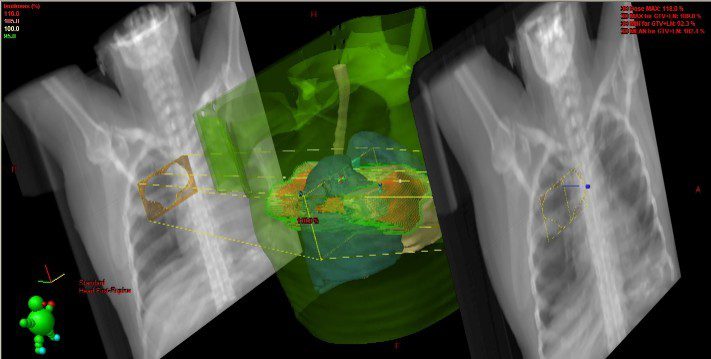Lung Cancer Choices© 6th Edition Menu
Chapter 1: Diagnosis and Staging of Lung Cancer
Chapter 2: Comprehensive Biomarker Testing
Chapter 3: Surgery for Lung Cancer Patients
Chapter 5: Radiation Therapy for Non-Small Cell Lung Cancer
Chapter 6: Treatment for Small Cell Lung Cancer
Chapter 7: Clinical Trials and Emerging Therapies for Lung Cancer
Chapter 9: Nutrition in the Patient with Lung Cancer
Chapter 10: Sexuality and Lung Cancer
Chapter 11: Integrative Medicine, Complementary Therapies, and Chinese Medicine in Lung Cancer
Chapter 12: Lung Cancer in People who have Never Smoked
Chapter 13: How to Quit Smoking Confidently and Successfully
Lung Cancer Question Builder - Develop your list of "Questions to Ask" your providers
Radiation Therapy for Non-Small Cell Lung Cancer
Join Y. Luh, MD, FACP, FACR and Charles R. Thomas, Jr., MD, FASCO, FASTRO
Introduction
Radiation is a form of energy that has both beneficial and harmful effects on humans. When used properly in controlled settings, radiation can effectively treat lung cancer, and this effect can be intensified with chemotherapy given at the same time. Radiation therapy is the medical use of radiation to treat cancer and some non-cancerous benign tumors. Radiation for cancer works by damaging the DNA of cancer cells. Cancer cells are much more sensitive to radiation than normal cells because while normal cells can repair the DNA damage caused by radiation, cancer cells are unable to repair such DNA damage. In addition, cancer cells are more sensitive to the effects of radiation and DNA damage because they divide much more rapidly than normal cells.
Lung cancers are categorized into two groups: small cell lung cancer (SCLC) and non-small cell lung cancer (NSCLC). Radiation may be used for SCLCs, as discussed in Chapter 6: Treatment for Small Cell Lung Cancer. This chapter will focus on the use of radiation therapy for NSCLC.
Principles of Radiation Therapy for Non-Small Cell Lung Cancer
Overview
The treatment of NSCLC depends on the cancer stage and the patient’s overall condition. Treatment options may include surgery, radiation therapy, chemotherapy, immunotherapy, and any combination of these options. Radiation therapy may be used before surgery, frequently in combination with chemotherapy, to make a tumor smaller and easier to remove. Radiation can be given after surgery, with or without chemotherapy, to kill any cancer cells that may still be present after surgery. Radiation with concurrent chemotherapy (chemoradiation), may be used to treat lung cancers that are too extensive to remove surgically. Radiation therapy can also be used alone, without surgery or chemotherapy.
The most common form of radiation therapy is external beam radiation therapy. With external beam radiation therapy, the patient lies on a table, and a beam or multiple beams are emitted from a machine known as a linear accelerator. The beams are directed to the tumor and surrounding tissues that may also contain cancer cells. The beams penetrate the skin, other tissues, and organs before reaching the tumor target. External beam radiation therapy is given daily during the week, Monday through Friday, typically for about 6 weeks. Scheduling the radiation treatment this way allows for an effective dose of radiation during the week to kill cancer cells and allows the patient and normal cells to recover during the weekend from the effects of radiation. The treatment takes 2 to 10 minutes, depending on the type of linear accelerator used.
The typical dose of radiation given for most lung cancers is 6000 to 7000 cGy (centigray), depending on the stage and whether or not chemotherapy is included. Such a high dose of radiation cannot be given all at once to a patient without lethal side effects. Therefore, the dose given per treatment is 180 to 200 cGy, which usually is better tolerated by patients. The unit centigray replaces the older term “rad” as a measure of radiation dose; 100 centigray is equal to 1 gray (Gy), which is equal to 1 Joule per kilogram of tissue (1 Joule = 1 Newton-meter).
Radiation Treatment Team
The delivery of radiation therapy requires several individual team members that play a crucial role in the successful treatment of patients. Radiation oncologists are medical doctors who have completed medical school and at least five years of residency training before joining the workforce. They are frequently certified by the American Board of Radiology (although they are not diagnostic radiologists). Radiation oncologists talk to, examine, and counsel patients for consultation, and design and direct the radiation treatment plan. Radiation oncologists are the physician specialists during a patient’s radiation therapy who provide evaluation, simulation (discussed next), weekly treatment visits, and follow-up visits after completing treatment (Figure 1).
Figure 1. A radiation oncologist confers with a medical physicist to develop a radiation treatment plan for a lung cancer patient
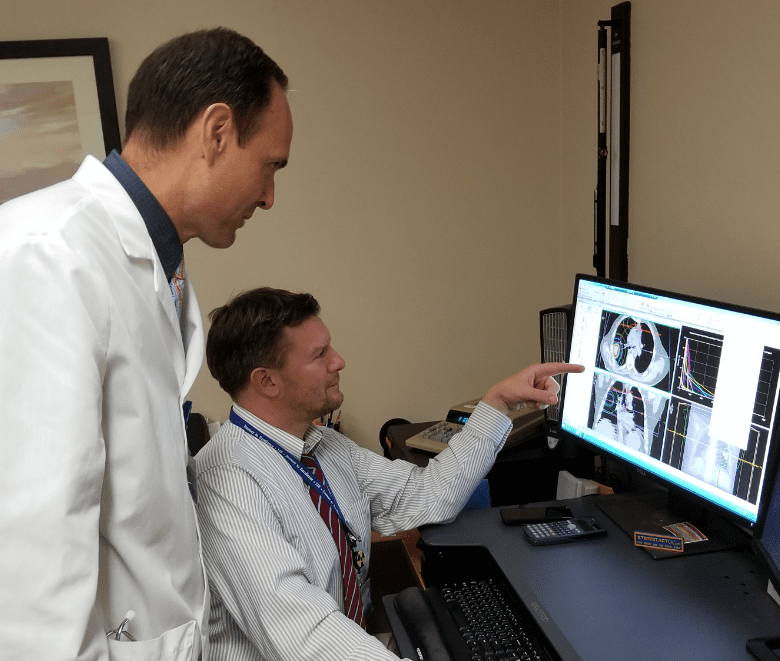
Radiation oncology nurses provide detailed education to patients on the clinical aspects of radiation treatment. They provide counseling on managing any side effects of treatment and tips on how to decrease the intensity of side effects. They often are the team members who address patient concerns and communicate more serious issues to the radiation oncologist.
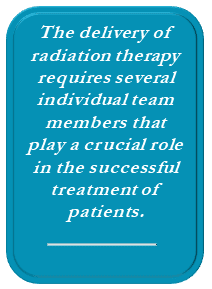 Dosimetrists help calculate and optimize the treatment plan designed by the radiation oncologist. They work to ensure that the intended dose of radiation prescribed by the radiation oncologist is delivered to the patient. They work closely with the radiation oncologist to determine the optimal angles, fields, and energy of radiation needed for a treatment plan.1 Most likely, you will not actually meet the medical dosimetrist, as their work on your treatment plan is behind the scenes.
Dosimetrists help calculate and optimize the treatment plan designed by the radiation oncologist. They work to ensure that the intended dose of radiation prescribed by the radiation oncologist is delivered to the patient. They work closely with the radiation oncologist to determine the optimal angles, fields, and energy of radiation needed for a treatment plan.1 Most likely, you will not actually meet the medical dosimetrist, as their work on your treatment plan is behind the scenes.
Medical physicists perform scheduled quality assurance tests to ensure that linear accelerators are working properly. They work closely with radiation oncologists and dosimetrists to help design the radiation treatment plan. They often supervise the dosimetrist in making sure the treatment plan is feasible and tailored to the individual patient. Most likely, you will not actually meet the medical physicist, as their work on your treatment plan is behind the scenes.
Radiation therapists operate the linear accelerators, place patients in the correct position, give the daily radiation treatments, and keep an accurate record of treatments given.1 Other staff members are important to patients receiving lung radiation, including social workers, physical therapists, occupational therapists, dieticians, and respiratory therapists.
Simulation
After the consultation with the radiation oncologist, and a decision has been made for a lung cancer patient to receive radiation therapy, the patient first must undergo simulation. Simulation is a procedure where a radiation oncologist and a simulation technician (usually a radiation therapist) place the patient in the exact position for treatment to ensure that the radiation hits the correct target consistently. The patient lies down on the back, usually with the arms placed above the head. There may be immobilization devices such as handlebars for the patient to hold onto above the head. Custom cradles may be molded to conform to the patient for lying in the same position for each treatment. Skin marks (which may be washed off) and permanent tattoos (pinpoint dots, no larger than a mole) are placed and lined up with laser pointers in the room to make sure the patient can lie in the same position each day. In some institutions, X-rays are taken after the patient’s treatment position has been determined.
Some radiation therapy facilities will gently place a belt around the patient’s abdomen to encourage the patient to take more shallow breaths during simulation and treatment. This is done to decrease the distance that the lung tumor may move up or down during breathing. Other techniques that help regulate the effect of breathing on tumor location include timed breath holding and the use of respiratory tracking (gating) systems that electronically follow the movement of the tumor (discussed in more detail below).2
Subsequently, a CT (computed tomography) scan of the neck and chest is done in the treatment position with all the immobilization devices in place (Figure 2). This CT scan will provide a computerized 3-dimensional digital virtual model of the patient’s chest and internal organs. The radiation oncologist and dosimetrist use this model to design a patient’s radiation treatment fields on a planning computer equipped with radiation treatment planning software. This planning or simulation CT scan is different from the diagnostic CT scan used to help diagnose and stage lung cancer. Intravenous contrast is sometimes used at the discretion of the radiation oncologist designing the treatment fields, and this contrast can provide better detail about the extent of lung cancer especially when lymph nodes in the chest are to be included into the treatment fields. Planning CT scans for simulation typically takes less time to obtain than diagnostic scans. Furthermore, planning CT scans are not routinely read or interpreted by a diagnostic radiologist but are processed with treatment planning software to help design the treatment fields.
Figure 2. A CT scan of the neck and chest is done in the treatment position with all immobilization devices in place
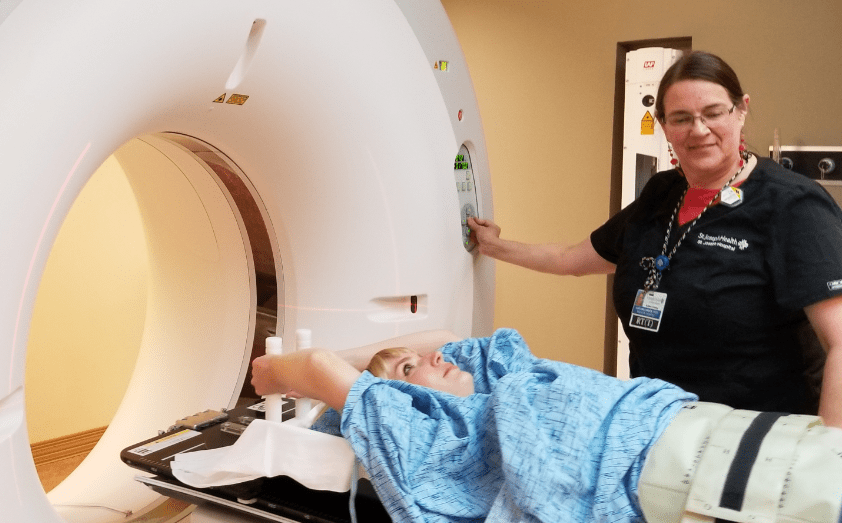
Some institutions use 4-dimensional CT, which is a planning CT scan that tracks how a patient’s breathing cycle affects the location of the lung tumor (a technique known as respiratory gating).2 The distance a tumor moves up, down, or sideways can be useful to the dosimetrist to determine the margin size around the tumor required for planning treatment. For tumor located in the middle or lower parts of the lung, there is likely to be movement of the tumor that coincides with respiration. In such cases, patients can be instructed to hold their breath for up to 30 seconds at a time. During the breath holding intervals, the tumor is less likely to move.
Treatment Planning
After the simulation is completed, the radiation oncologist, dosimetrist, and medical physicist develop a customized treatment plan that is designed for the individual patient. This process can take between 3-7 days to complete.
The simulation CT scan images are electronically sent to a computer with treatment planning software. The slices of the CT scan are reviewed, and the anatomic structures, such as the lungs, heart, esophagus, chest wall, ribs, and spinal cord, are outlined or contoured in different colors. The sum of the slices of these contours defines the volume of the anatomic structures (Figure 3).
Figure 3. Contours of Normal Organs and the Gross Tumor Volume
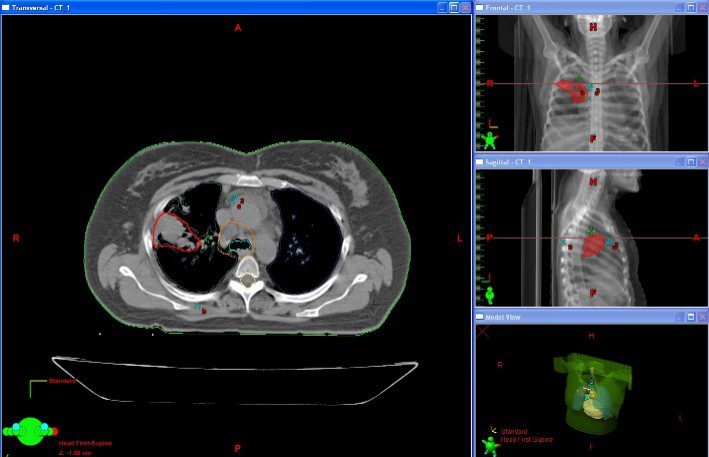
The radiation oncologist, using information from positron emission tomography (PET) scans (Figure 4), diagnostic CT scans, and other reports will contour the actual tumor and lymph nodes involved with cancer. The volume of the actual tumor is called the gross tumor volume, and the gross tumor volume frequently is contoured in a bright color such as red.3 At some centers, the dosimetrist can take a PET scan (previously obtained to stage the tumor) and fuse this with the simulation CT scan. Because the lung tumor and regional lymph nodes light up brightly on the PET scan, fusion with the simulation CT scan can greatly help the radiation oncologist define the volume of cancer with more accuracy. In fact, using a PET scan with treatment planning results in more accurate targeting of the tumor, resulting in less radiation to normal tissues, less chance of the tumor growing back, and slightly longer survival than patients getting treatment planning with CT alone.4
Figure 4. PET/CT scan showing location and shape of active lung cancer
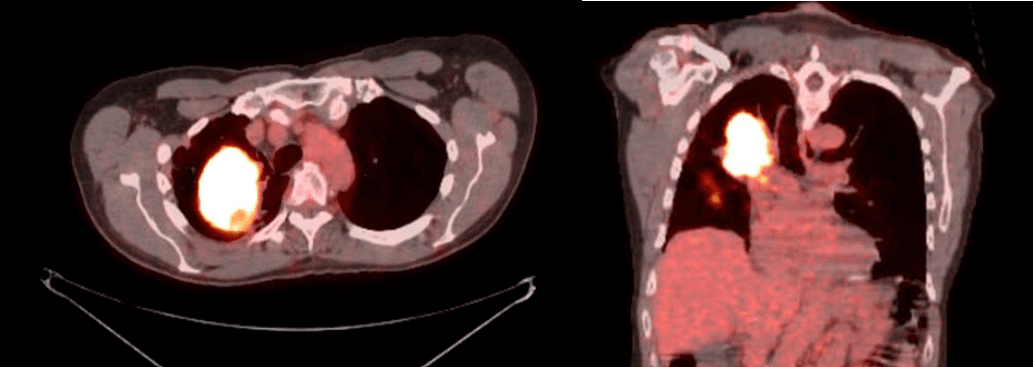
After the normal tissue volumes and gross tumor volume have been defined, the tumor is more clearly seen in relation to other organs. The dosimetrist or radiation oncologist set up portals or fields that surround the gross tumor volume and the involved lymph nodes in the mediastinum. The mediastinum is a space in the middle of the chest that includes the esophagus, trachea, and large blood vessels above the heart; this space is rich in lymph nodes and lymph vessels, making it a common place for lung cancer to spread.3
Three Dimensional Conformal Radiation Therapy
The classic method used to treat lung cancer involves two fields: one field is oriented facing the patient’s front chest (anteroposterior [AP]) and one field is oriented facing the patient’s back (posteroanterior [PA]). The term AP/PA is used to describe this setup (Figure 5). This method is used much less in the United States in favor of intensity modulated radiation therapy (IMRT) discussed in the next section.
Figure 5. Computer Generated Image of Chest Fields
The initial AP/PA fields frequently include the spinal cord (Figure 5a). The spinal cord can usually tolerate 5000 cGy before the risk of spinal cord damage occurs. Radiation oncologists usually aim to keep the spinal dose below 4500 to 5000 cGy but may use a lower dose when chemotherapy is used concurrently with radiation. Most lung cancer treatments involve doses of 6000 to 6600 cGy, so the patient cannot be treated using AP/PA fields for the entire treatment. Therefore, the patient is treated using AP/PA fields to a dose between 4000 to 5000 cGy, and then the fields must be modified. As you can see from Figure 5a, the radiation dose is shaped more like a rectangle and results in some normal lung getting the similar doses as the tumor volume.
Figure 5a. Orientation of AP/PA Fields Including the Spinal Cord
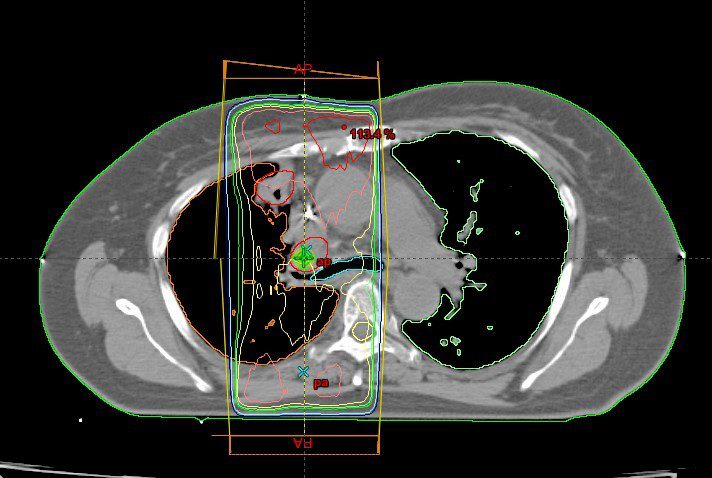
The modified fields are called the “off-cord boost”. The typical method of designing an off-cord boost is to change the angle of the fields to where they are oblique or diagonal and avoid the spinal cord (Figure 5b). Attempts are made to include the involved lymph nodes with the gross tumor volume and safely avoid the spinal cord. However, if this is not possible, the off-cord boost may treat only the gross tumor volume. The inclusion of the involved lymph nodes in the off-cord boost can also be done with the use of intensity modulated radiation therapy.
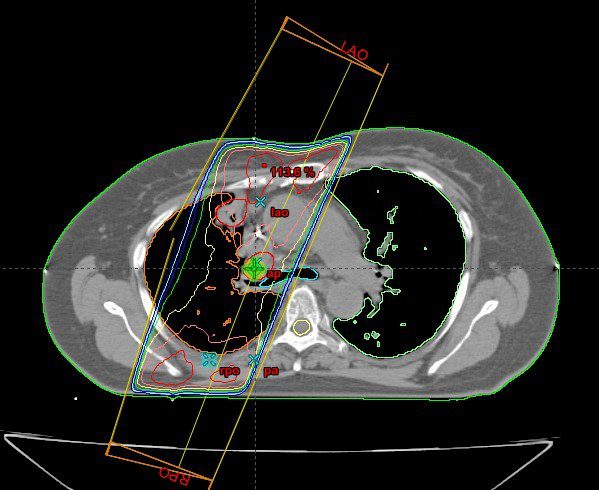
Intensity Modulated Radiation Therapy
A technique known as intensity-modulated radiation therapy (IMRT), uses multiple beams or fields directed at the gross tumor volume and involved lymph nodes, and is becoming a recognized standard technique used to treat lung cancer. A 1.0 to 2.0 cm margin is usually placed around the visible tumor to account for tumor movement (from breathing, setup variation, and patient motion). IMRT has been the preferred method of treating lung cancers in the United States. With IMRT, the intensity of each beam directed at the tumor can be varied to where the sum of all the beams adds up to a dose cloud that better conforms to the shape of the tumor (Figure 6). Although IMRT allows a radiation oncologist to spare more normal lung and other normal tissues from the high dose meant for the tumor, it spreads low dose radiation to a larger area. Despite this, IMRT can give higher and more effective doses to any tumor and limit the radiation dose to normal organs that do not need to be radiated. The technical aspects of IMRT are beyond the scope of this chapter, but a helpful website with information on IMRT can be found at http://www.radiologyinfo.org/en/info.cfm?pg=imrt.
Figure 6. Rendering of Doses in a VMAT IMRT Plan
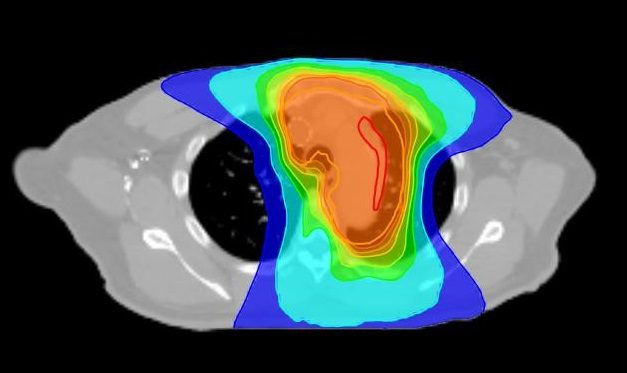
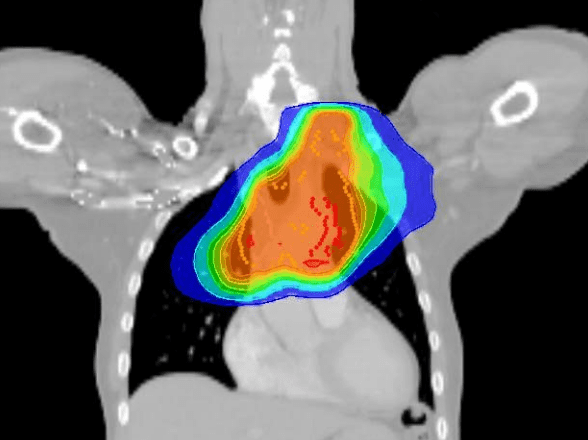 Images courtesy of Steve Rhodes, M.S., R.T.(T), CMD
Images courtesy of Steve Rhodes, M.S., R.T.(T), CMD
Traditional IMRT uses a “fixed-field” or “step and shoot” approach which uses a limited number of beam angles to treat the lung cancer. A newer version of IMRT is volumetric modulated arc therapy (VMAT) which uses continuous arcs of radiation beams providing many more angles for IMRT planning, resulting in a smoother shape of radiation. VMAT can deliver the treatment much faster (one to two minutes) than a typical fixed-field technique (five to fifteen minutes). Newer linear accelerators tend to deliver treatments faster (Figure 6a).
Figure 6a. A 7-field “step and shoot” IMRT plan
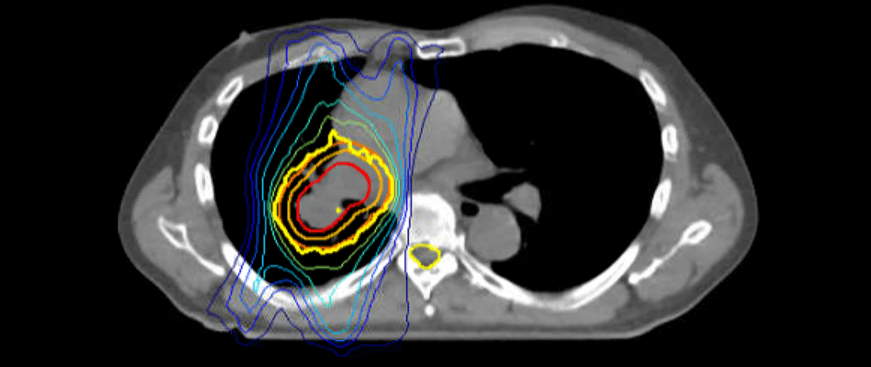
When the field designs have been completed, the dosimetrist will calculate how effective the fields may provide the radiation dose to the gross tumor volume. The dosimetrist will also calculate how much radiation the surrounding tissues are receiving, such as the spinal cord, heart, and lungs. If any of these tissues receive radiation beyond a maximum threshold, then the fields must be adjusted. The V20 is the volume of both lungs that receive ≥ 20 Gy (2000 cGy); dosimetrists attempt to keep the V20 below 30% because the risk of a serious side effect known as radiation pneumonitis increases dramatically if V20 > 35%.5
After the treatment plan is completed, the patient returns to the radiation therapy department for a block check or verification procedure (Figure 7). The patient is placed on the actual treatment machine (linear accelerator) in the same position as in the simulation CT scanner. Radiographs are made and reviewed to make sure that the images match the images on the planning CT scan and are consistent with the CT based treatment plan. Many treatment centers perform a low energy CT scan called a cone beam CT (CBCT) on the treatment table and overlay this CT with the planning CT scan to give a more precise confirmation of the accuracy of the field being treated and to enable any needed adjustments because of setup variations (see section on Quality Assurance). Whether you receive 3D conformal, multi-field IMRT, or VMAT, your radiation oncologist will determine which technique is best for your specific case.
Figure 7. A Block Check or Verification Before Starting Treatment
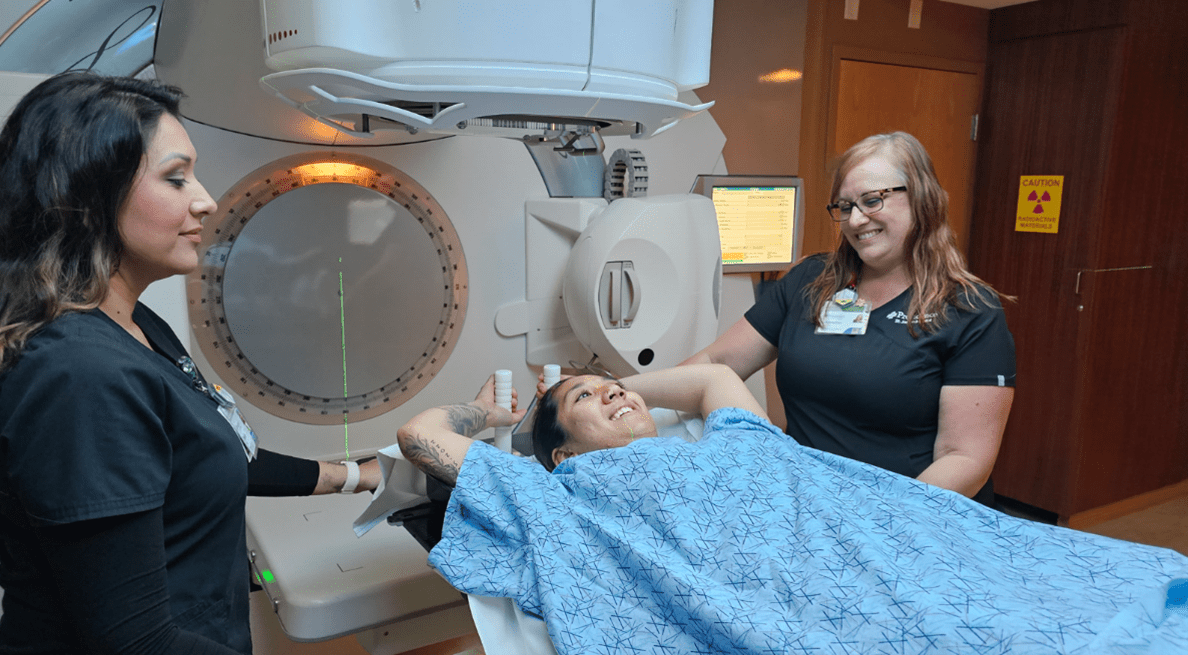
Treatment
Radiation treatment usually starts the day after the block check or verification. For most lung cancer patients, radiation is given every day from Monday to Friday, with weekends off, for approximately seven weeks. The patient is on the treatment table receiving radiation for 5 to 10 minutes sometimes fewer with a newer machine (Figures 8 and 8a). Patients are usually in the department for 20 to 30 minutes or less, to include arrival to the waiting room, checking in with the front desk, changing into a gown, being escorted to the linear accelerator vault, getting in the treatment position on the treatment table, and having the radiation therapist make any needed adjustments.
Figure 8. A Patient on the Table of a Linear Accelerator Receiving Radiation Treatment. Note the yellow laser cross hairs to the left of the patient’s nipple.
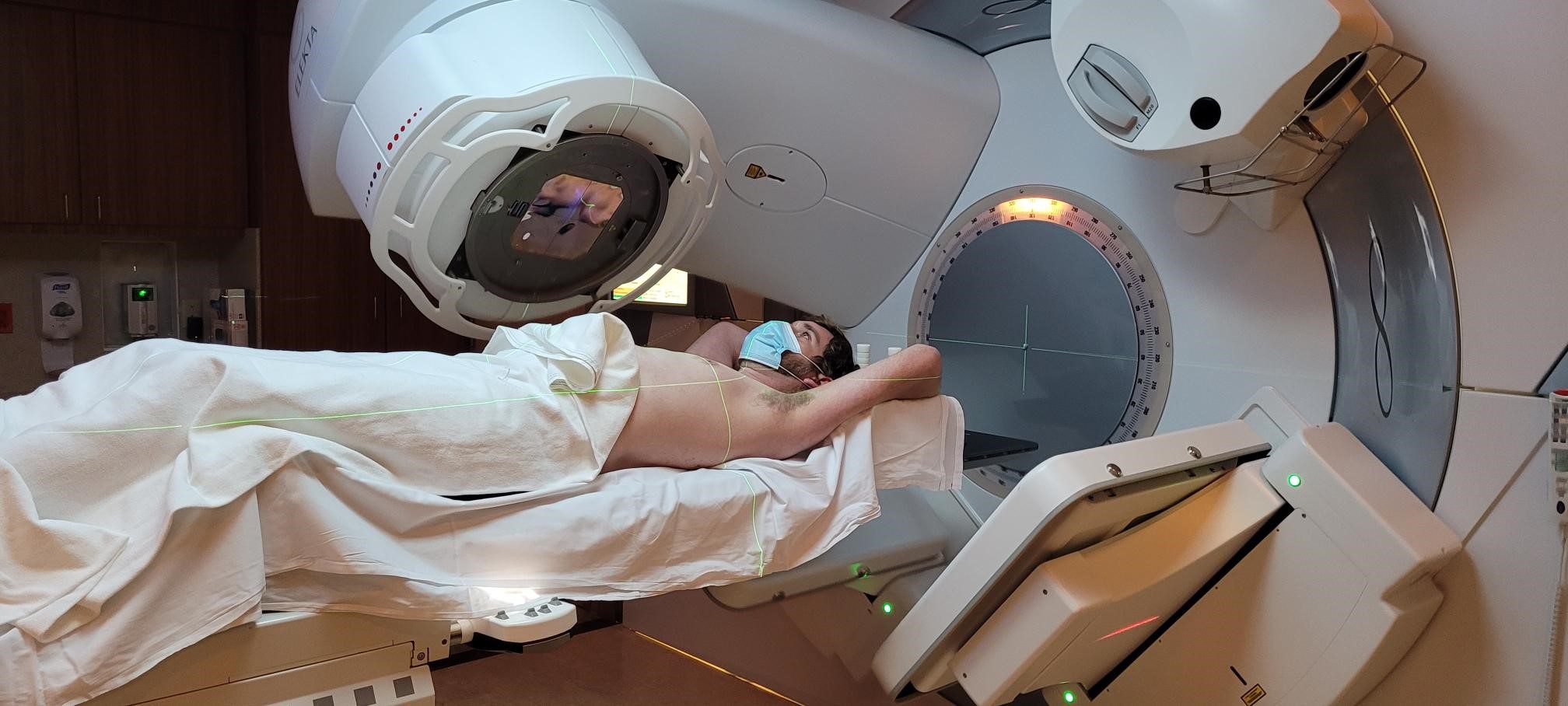
Figure 8a. Radiation therapists operating the linear accelerator from the console with the ability to view and communicate with the patient in real time.
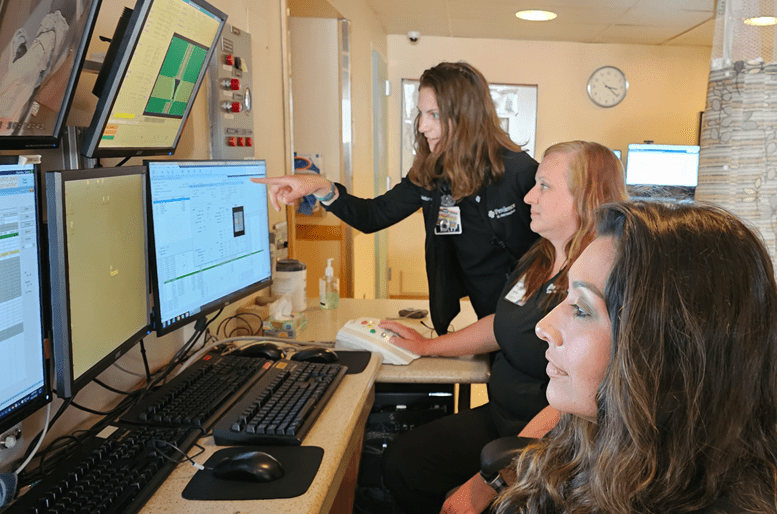
The patient will meet with the radiation oncologist once a week on a specified day to see how the patient is feeling. During these weekly visits, the patient can ask any questions that may not have been addressed during the consultation. The radiation oncologist will check to see if there are any side effects from the radiation treatment (such as skin irritation or heartburn) and may prescribe medication to help with these side effects. See Questions to Ask Your Treatment Team
Quality Assurance
Traditionally for 3-D conformal radiation therapy, an X-ray is taken every five treatments with a beam’s eye view of the treatment fields. The radiation oncologist would compare this X-ray to images (digitally reconstructed radiographs (DRR’s)) generated from the planning CT scan with the treatment fields in place to ensure that the tumor is being targeted accurately. It is difficult to see actual organs and tumor in these films, so the bones (ribs and spine) serve as landmarks for the treatment fields. If the fields are off by more than 5 to 10 mm, the radiation oncologist will instruct the radiation therapist to make a shift in the direction(s) to offset the difference. This technique of obtaining X-ray port films every five treatments has largely been replaced by image-guided radiation therapy (IGRT) with cone-beam computed tomography (CBCT) built into the linear accelerator, allowing for a low energy CT scan to be done prior to every treatment and aligned to the treatment planning CT scan. This form of IGRT has become very popular and allows the radiation therapist to more realistically align the patient’s daily anatomy to the treatment planning CT structures (such as the lung tumor and windpipes), instead of just bones (Figures 9 and 10).6
Figure 9. (Left) A digital reconstructed radiograph (DRR), reconstructed from the patient’s planning simulation CT and (Right) a port film taken from the linear accelerator with the patient on the table. Note the port film is similar to a plain X-ray and lacks detail in soft tissues, so the physician relies on bones to determine the accuracy of the field.
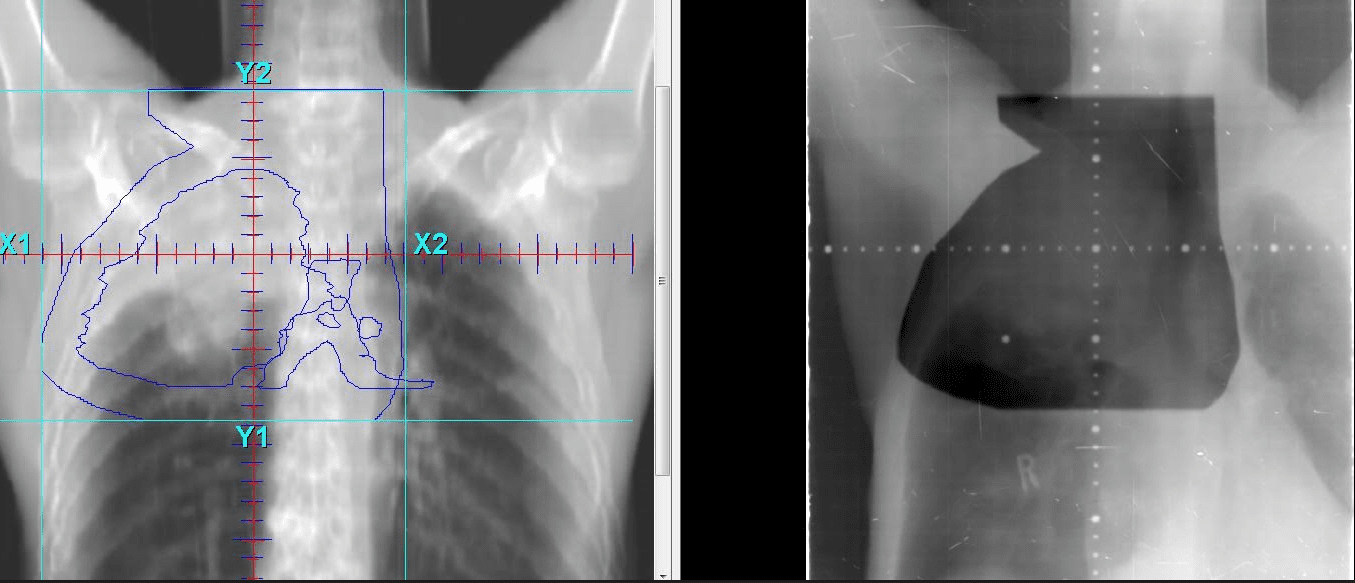
Figure 10. Modern image guided radiation therapy (IGRT) with the use of cone beam CT. The purple images are taken from the patient’s planning simulation CT and the green images are the cone beam CT taken from the linear accelerator with the patient on the table. Note the increased detail and ability to see the organs and tumor in 3 different planes.
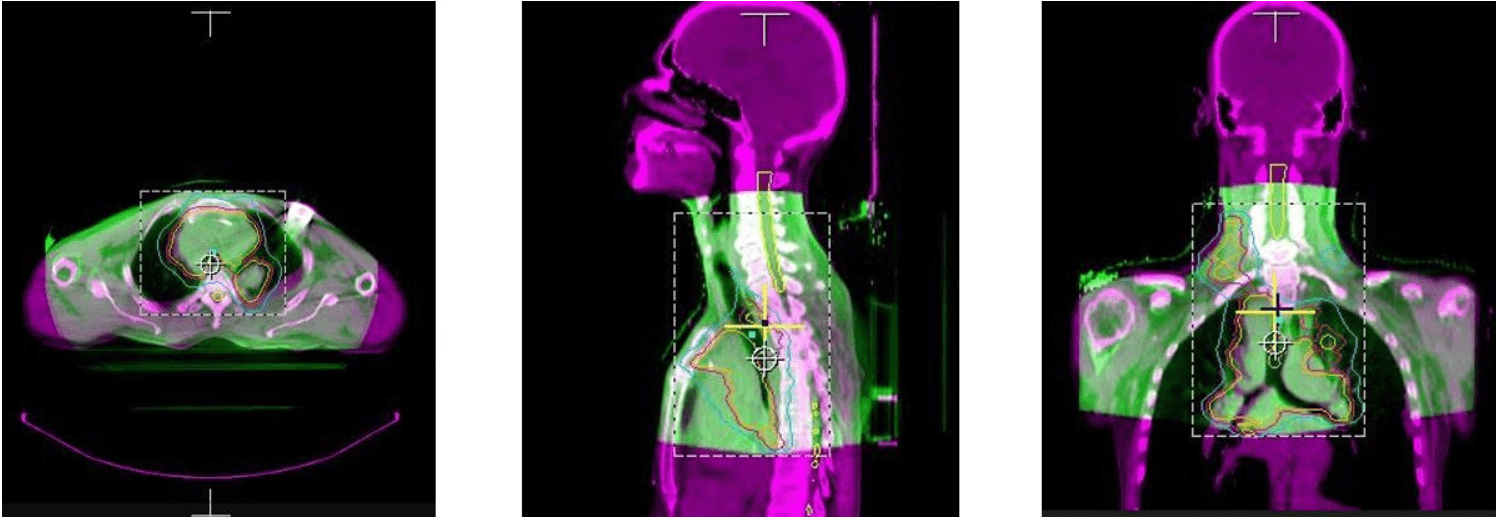
Radiation Therapy for Different Stages
Stage I and II Non-Small Cell Lung Cancer
Surgery, usually a lobectomy, is the typical treatment for stage I and II NSCLC. However, not all patients have surgery, either because of a personal preference to avoid surgery or because of medical conditions, such as severe emphysema or heart disease, that increase the risk of surgery and anesthesia. If surgery cannot be done for stage I or II NSCLC, radiation therapy is a good alternative.
Conventional Radiation
In centers that do not have access to stereotactic radiation techniques (discussed below), conventional radiation therapy for stage I and II NSCLC is still an accepted treatment. Conventional radiation for lung cancer gives a total dose of 6600 to 7000 cGy to the lung tumor volume, in doses of 180 to 200 cGy per day over seven weeks. Stage I and II NSCLCs have not spread to the lymph nodes in the middle of the chest between the lungs (mediastinum), so only the lung tumor is treated, making the amount of tissue radiated much smaller.7
Many patients cannot commit to a 7-week course of daily radiation therapy, especially if they must travel long distances to reach a radiation treatment facility. In these cases, effective doses of radiation can be given over a shorter period if larger doses are given per treatment, a technique called hypofractionation. However, larger doses per treatment may result in more tissue scarring, especially in long term survivors. Therefore, to minimize the effect of lung scarring caused by hypofractionation, radiation must be limited to a smaller volume of tissue. For fragile patients who are too sick to come for treatment for seven weeks, hypofractionation to a total dose of 6000 cGy in fractions of 400 cGy over 15 treatments (3 weeks) has been used successfully.8
Stereotactic Radiosurgery
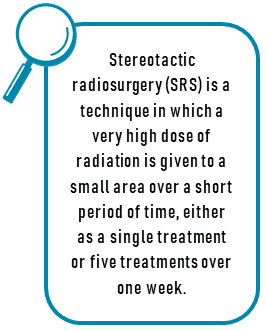 Stereotactic radiosurgery (SRS) is a technique in which a very high dose of radiation is given to a small area over a short period of time, either as a single treatment or five treatments over one week. The term SRS has always been used to describe this technique for brain tumors. Radiosurgery, contrary to what the term implies, is not surgery and does not involve any incision or cutting by the radiation oncologist, but the high dose of radiation results in the killing of the tumor as if it was surgically removed. The high precision of the multiple beams used in stereotactic radiosurgery results in the margins around the gross tumor volume being much smaller (0.5 cm to 1.0 cm) than with typical radiation therapy techniques. Gamma Knife, CyberKnife, and linear accelerator-based SRS (TomoTherapy®, Elekta VMAT, and RapidArc®) are examples of proprietary methods of delivering SRS using a linear accelerator. Gamma Knife® is only used for SRS to brain lesions.
Stereotactic radiosurgery (SRS) is a technique in which a very high dose of radiation is given to a small area over a short period of time, either as a single treatment or five treatments over one week. The term SRS has always been used to describe this technique for brain tumors. Radiosurgery, contrary to what the term implies, is not surgery and does not involve any incision or cutting by the radiation oncologist, but the high dose of radiation results in the killing of the tumor as if it was surgically removed. The high precision of the multiple beams used in stereotactic radiosurgery results in the margins around the gross tumor volume being much smaller (0.5 cm to 1.0 cm) than with typical radiation therapy techniques. Gamma Knife, CyberKnife, and linear accelerator-based SRS (TomoTherapy®, Elekta VMAT, and RapidArc®) are examples of proprietary methods of delivering SRS using a linear accelerator. Gamma Knife® is only used for SRS to brain lesions.
Stereotactic Body Radiation Therapy (SBRT)
Stereotactic radiation therapy for tumors outside of the brain is known as stereotactic body radiation therapy, stereotactic ablative radiotherapy (SABR), or extracranial radioablation (ECRA). SBRT is the most common term to describe any type of stereotactic radiosurgical technique to treat tumors in the spine, lung, liver, pancreas, adrenal glands, or lymph nodes—anything outside the brain or spine. This method is widely used for patients with stage I or II NSCLC (Figures 11, 12, and 13) who are either too frail for surgery or do not want surgery, with comparable or better outcomes when compared with the conventional radiation therapy techniques described above.7, 9 Dose schedules in stereotactic body radiation therapy include either a total dose of 2500 to 3400 cGy in one single treatment, 4500 to 6000 cGy given in 3 treatments of 1500 to 2000 cGy over a period of one to two weeks, a total dose of 4800 cGy given in 4 treatments of 1200 cGy, or a total dose of 5000 cGy given in 5 treatments of 1000 cGy daily over 1 week.
Figure 11. A Rendering of Dose and Beams in a SBRT Plan
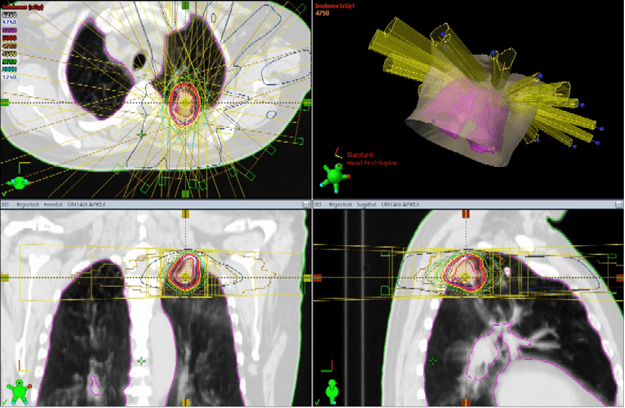
Image courtesy of Steve Rhodes, M.S., R.T.(T), CMD
Figure 12. Before SBRT
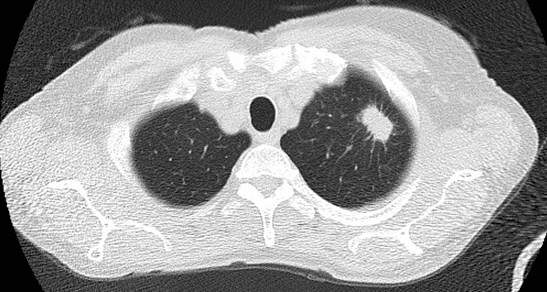
Figure 13. After successful SBRT
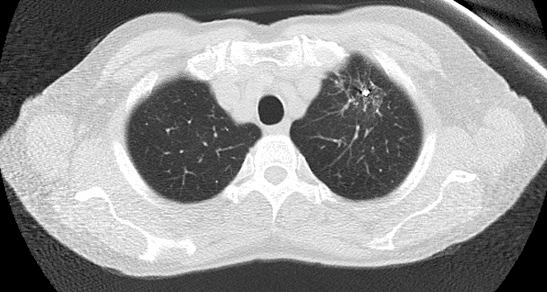
A patient may be treated with SBRT for NSCLC if the lung tumor is ≤ 5 cm in greatest diameter and peripheral to the mediastinum (more to the side of the chest away from the heart, esophagus, trachea, and major blood vessels, rather than the middle).10 Larger tumors or tumors closer to the middle of the chest (mediastinum) that are right next to important organs (heart, esophagus, main bronchi, aorta, superior vena cava) are more safely treated with doses of 6000 to 7000 cGy over eight to ten treatments. CyberKnife and linear accelerator based SBRT (TomoTherapy®, Elekta VMAT, and RapidArc®), are examples of proprietary methods of delivering SBRT. Again, Gamma Knife® is not used in SBRT because it is only used for treating brain tumors with SRS. See further discussion of SRS for brain metastases below.
Stage III Non-Small Cell Lung Cancer
Most cases of stage IIIA and IIIB NSCLC are inoperable (except for some cases of stage IIIA cancer) because of the extent of disease. For patients with inoperable stage IIIA and stage IIIB NSCLC, recommendations for treatment in the National Comprehensive Cancer Network (NCCN) include concurrent chemotherapy and chest radiation therapy. The first doses of chemotherapy and radiation therapy are given on the same day. Depending on the drug selected, the chemotherapy is given at varying intervals, but radiation therapy is given daily. The typical dose of radiation therapy, when given with chemotherapy, is 6000 to 7000 cGy given in 180 to 200 cGy fractions over seven weeks. The typical intravenous chemotherapy regimens given in combination with radiation therapy are: (1) cisplatin (days 1, 8, 29, and 36) and etoposide (days 1 to 5 and 29 to 33); (2) cisplatin (weeks 1 and 4) and vinblastine (weekly); or (3) weekly carboplatin and paclitaxel.11
For stage III NSCLC that is marginally or borderline operable, treatments can be given to increase the chancel for a successful surgery. This can include giving chemotherapy, chemotherapy with immunotherapy, or chemotherapy with radiation therapy before surgery to decrease the size of the lung mass and mediastinal lymph nodes.12 If radiation is given with chemotherapy with the intention of doing surgery later, the radiation dose is typically only 4500 cGy, and the patient has another CT scan with or without a positron emission tomography (PET) scan to evaluate response. If the tumor appears operable, then surgery is done. However, if the lung cancer remains inoperable, then the patient would be given further radiation for a total dose of at least 6000 cGy with chemotherapy, similar to other patients with inoperable NSCLC.11
Radiation Therapy After Surgery
In some cases, in which surgery is done for a stage I or II NSCLC, postoperative evaluation of the mediastinal lymph nodes that had been sampled during surgery may show these nodes to be positive for cancer. In this situation, the stage of NSCLC is revised to stage III. For such patients, surgery alone is not sufficient treatment, and the patient will require at least chemotherapy and possibly radiation.12-13
If there is a suspicion that there is cancer remaining in the patient after surgery, demonstrated by a positive margin of resection (meaning there are cancer cells at the edge where the surgeon had excised the tumor), or the presence of cancer containing lymph nodes in the mediastinum with extracapsular extension (meaning the cancer has broken through the capsule of the lymph node, multiple lymph nodes with cancer, or concerns that not enough lymph nodes were removed, then radiation therapy (usually to a dose of 5000 cGy or more) is given with concurrent or sequential chemotherapy. If the surgery was complete with clear margins of resection (a rind of normal tissue surrounds the tumor) and mediastinal lymph nodes with cancer that have not broken through their capsules, then the chemotherapy with or without immunotherapy is given.14-15
Although radiation therapy given after surgery in stage III lung cancers has lowered the risk of the cancer growing back in the chest, it has not helped patients live longer, which is why radiation therapy after surgery in these patients is no longer automatically offered after a clean surgery.
Stage IV Non-Small Cell Lung Cancer
In stage IV NSCLC, cancer has either spread to the opposite lung, metastasized to a different organ (such as the liver, brain, or bones), or produced fluid containing cancer cells within the space surrounding the lung (a condition known as a malignant pleural effusion). The primary treatment for patients with stage IV NSCLC is chemotherapy, chemotherapy with immunotherapy, or immunotherapy alone. The various drugs used in stage IV NSCLC are discussed in more detail in the chapter on chemotherapy for NSCLC. See Chapter 4: Systemic Therapy for Non-Small Cell Lung Cancer.
Radiation therapy to the lung typically does not improve the lifespan of a patient with stage IV NSCLC and is not routinely used in these cases.16 However, if a patient with stage IV cancer has a large lung mass that is causing chest pain, facial/neck/arm swelling, difficulty swallowing, shortness of breath (collectively known as superior vena cava syndrome), or bleeding from the windpipes, radiation therapy to the lung mass may be given, typically in doses from 3000 cGy (10 treatments of 300 cGy fractions over two weeks) to 5000 cGy (20 treatments of 250 cGy fractions over four weeks).17-18, 8
Palliative Radiation Therapy for Sites of Metastases in Stage IV Non-Small Cell Lung Cancer
Brain Metastases
Stage IV lung cancers may spread or metastasize to the brain. Because standard chemotherapy does not enter the brain (the blood brain barrier shields the brain from toxic substances in the blood), radiation therapy is often the first line treatment for brain metastases when patients cannot get surgery to remove the tumors. When there are multiple brain tumors (typically over 10 to 15), whole brain radiation therapy is frequently given to the entire brain to shrink the existing tumors and prevent new brain metastases from forming. The most common dose given for whole-brain radiation therapy is 3000 cGy (10 treatments of 300 cGy fractions over 2 weeks), although patients with a good performance status with estimated survival of more than 6 months can receive 3750 cGy (15 treatments of 250 cGy over 3 weeks), as a more “gentle” treatment that may result in less cognitive side effects, although there is no clinical trial data to support this. Side effects of whole-brain radiation therapy (WBRT) include fatigue, drowsiness, alteration in taste/smell, hair loss, and scalp itchiness. The primary long-term effect of WBRT is short term memory loss. WBRT in adults does not cause personality changes, Alzheimer’s disease, or mental retardation. Typically, an engineer or accountant will have more difficulty doing math in their heads and will have to write things down. Memantine, a drug FDA approved to treat Alzheimer’s dementia, has been shown to reduce the rate of decline in memory, executive function, and processing speed in patients receiving WBRT. 19 Another technique to preserve brain function is to avoid treating the part deep in the brain that has a major role in learning and memory called the hippocampus. This technique is call hippocampal-avoiding (HA) WBRT. If no brain metastases are seen in the hippocampus, HA WBRT is safe and effective.20
If a patient has five or less brain metastases and all the lesions are 3 cm or less in diameter, the patient may have surgery to remove the metastases, followed by WBRT to prevent new tumors from forming,21 or followed by stereotactic radiosurgery (SRS) to the resection cavities (the “hole” left after tumor removal). The patient could also be treated with just stereotactic radiosurgery (SRS). SRS for brain metastases has the advantage of allowing for less radiation to the rest of the brain, but the disadvantage is that new brain metastases could form in areas that were not radiated. Nevertheless, with follow up MRI brain imaging done every 3 to 4 months, patients can be monitored for any new brain metastases. SRS is the preferred form of radiation therapy over WBRT for those with “limited” brain metastases (typically 5 or less, although this number is increasing) (Figure 14).22 As mentioned previously SRS can be given using a variety of proprietary methods such as Gamma Knife® (see gammaknife.com) or linear accelerator SRS (TomoTherapy®, Elekta VMAT, and RapidArc®). Nevertheless, many experts would recommend WBRT if there are more than 15 brain metastases, due to the high risk of having many smaller metastases that are not readily visible on MRI images.
Figure 14. A Rendering of Dose and Beams in a SRS Plan
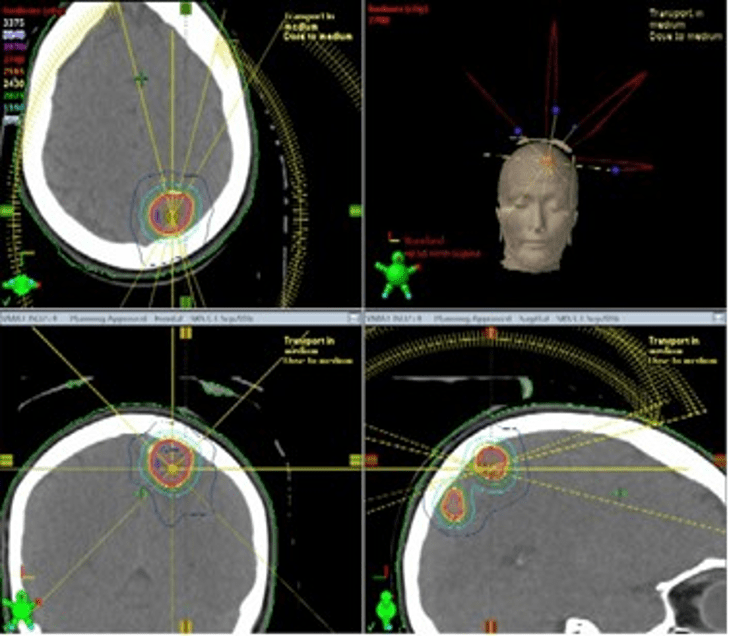
Image courtesy of Steve Rhodes, M.S., R.T.(T), CMD
There are also situations where a patient may have multiple tiny brain metastases that are not causing any symptoms. If the patient’s lung cancer has the appropriate mutation or molecular profile, then immunotherapy and/or biologic therapies administered by a medical oncologist can potentially treat these metastases without radiation therapy, since some of these drugs can cross the blood brain barrier. In these situations, radiation therapy either in the form of WBRT or SRS can be reserved for later time if these brain tumors re-appear are not responding to immunotherapy or biologic therapy.
Spine Metastases
When lung cancer spreads to the vertebrae, patients may experience severe back pain. Growing cancer could compress the spinal cord and cause paralysis. These metastases can be removed surgically, especially if there is only one metastatic lesion. In this case, radiation therapy is given 1 to 2 weeks after surgery to prevent cancer from recurring in the spine.23 If metastases are too extensive to remove surgically, radiation therapy alone is used, most commonly at a dose of 3000 cGy (10 treatments of 300 cGy fractions over two weeks). In cases where a previously treated vertebral body metastasis comes back, stereotactic body radiation therapy (SBRT) can be used to better avoid previously treated tissue and concentrate radiation to the areas involved by cancer, using techniques similar to SRS of the brain.
Metastases to Other Organs
Lung cancer can also spread to the liver, adrenal glands, and bones. When this occurs while the patient is receiving systemic therapy (chemotherapy, biologic therapy, with or without immunotherapy), this is a sign that the cancer has become resistant to the drug(s). Radiation therapy (either conventional radiation or SBRT) can be used to treat these areas if surgery is not an option. Palliative radiation is effective in reducing or eliminating 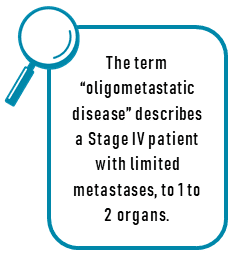 pain in patients where cancer has spread to any bone (ribs, hips, vertebra, etc.).
pain in patients where cancer has spread to any bone (ribs, hips, vertebra, etc.).
The term “oligometastatic disease” describes a stage IV patient with limited metastases, to 1 to 2 organs. In the past, these patients were still treated with just systemic therapy, but research has shown that for patients with fewer than three metastatic tumors, and stable (not progressing) disease, radiation therapy to these affected areas improves survival (17 months) compared to getting systemic therapy alone (10 to 12 months)24
Alternate Forms of Radiation Therapy for Non-Small Cell Lung Cancer
Proton beam therapy is a form of external beam radiation therapy that uses protons (usually from a hydrogen atom) instead of x-rays. Proton beams do not have any exit dose beyond the target tumor. Therefore, the radiation from proton beams is deposited only along the path of the beam to the tumor, and no radiation is given behind the tumor, so the patient receives less radiation to nearby normal tissue. Proton beam therapy is available only in slightly over 20 centers in the United States and is used in unique situations, such as in children with brain or spinal tumors where it is critical to protect as much normal tissue from radiation.1 In lung cancer, proton beam therapy is especially useful in patients who have previously been treated with conventional radiation therapy and need repeat treatment to the same area (Figure 15).
Figure 15. A Rendering of Dose in a Proton Plan Versus a 3-D Conformal Plan
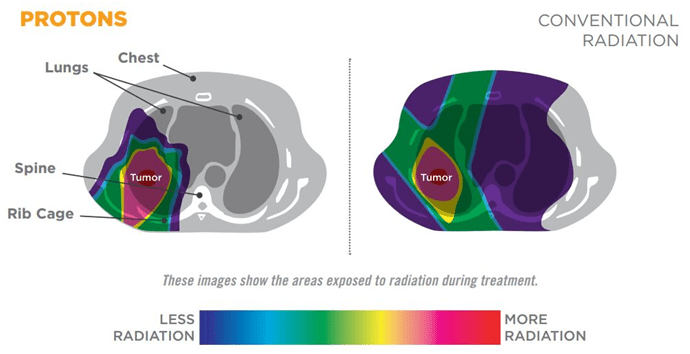
Graphic courtesy of Provision Center for Proton Therapy in Knoxville, TN | ProvisionProton.com
With brachytherapy, the radioactive sources are placed in or just next to the tumor. High dose rate brachytherapy involves the accurate placement of a powerful radiation source, usually iridium-192, into the tumor for several minutes through a tube called a catheter.1 Endobronchial brachytherapy involves the placement of a catheter into a lung bronchus or bronchiole where there is a tumor. The iridium-192 source is placed into the catheter where it remains for a few minutes, exposing a small area of the lung to a high dose of radiation. Endobronchial high dose rate brachytherapy is useful for treating pain, shortness of breath, cough, and hemoptysis (coughing up of blood). 25
Side Effects of Lung Radiation Therapy
Acute side effects occur when a patient is receiving lung radiation therapy with or without chemotherapy. These include redness and irritation of the skin overlying the radiation treatment portals; inflammation of the esophagus (esophagitis) causing heartburn or a feeling that something is stuck in the throat; irritation of the lung causing a dry cough; inflammation of the sac surrounding the heart causing chest pain (pericarditis); electric shock sensations in the low back or legs when bending the neck (Lhermitte sign); and generalized fatigue. These acute side effects typically resolve two weeks after completing chest radiation therapy.
With regards to the skin reaction over the skin of the chest corresponding to the treatment portals, the intensity of the reaction is typically increased when chemotherapy is given during the radiation treatment. The skin over the back (posterior chest) tends to be more affected than the front (anterior chest). Patients can get a sunburn-like reaction with a painful burning sensation that can progress to skin peeling (often called desquamation). Although the skin effects are well tolerated by most patients, a small number of patients can develop severe redness and skin peeling and require daily wound care. Fortunately, such severe skin reactions are not frequent. The skin heals fairly quickly after completing radiation, and most redness and peeling resolve in 4 to 6 weeks. By the 3-month mark, there may be a tan corresponding to the radiation treatment fields. Permanent skin scarring occasionally occurs in those with more severe skin reactions during treatment.
Subacute side effects occur 1 to 6 months after completing radiation therapy. These side effects are less frequent and may include radiation pneumonitis, which is inflammation of the lung that causes chest pain, fever, and cough.26 As mentioned above in the section on treatment planning, radiation pneumonitis infrequently occurs, especially when the V20 (volume of both lungs receiving ≥ 20 Gy or 2000 cGy) is no more than 35%. Your radiation oncologist, dosimetrist, and physicist work hard to ensure that the least amount of radiation possible goes to normal lung without sacrificing coverage of the lung tumor. Treatment of radiation pneumonitis includes corticosteroids such as prednisone or dexamethasone.
Another rare subacute side effect is pericardial effusion in which fluid accumulates in the pericardium (the sac surrounding the heart), causing tamponade (pressure on the heart) with symptoms such as neck vein distention, shortness of breath, and a rapid heart rate. Pericardial effusions may resolve spontaneously, but in some cases, treatment may include needle aspiration to drain the excess fluid or diuretics.
Long-term side effects of lung radiation therapy include pulmonary fibrosis (permanent scarring of the radiated lung tissue), esophageal fibrosis and stricture (scarring and narrowing of the esophagus that causes difficulty swallowing and treated with esophageal dilation), constrictive pericarditis (shrinkage of the sac surrounding the heart, that may require surgical removal), and damage to the heart muscle and blood vessels that may increase the risk of heart failure and heart attack. These long-term side effects have become less common because modern radiation therapy techniques have resulted in better sparing of normal tissues and organs.
More online information and videos on the role of radiation therapy in lung cancer can be found at https://rtanswers.org/Cancer-Types/Lung-Cancer.
The authors wish to thank Steve Rhodes, BS RT(T) CMD, Debra Monaco, CMD, RT (R) (T), Barbara Agrimson, CMD BS RT (R)(T), and Paul H. Cooper, Phys, CMD for submitting some of the treatment planning images used in this chapter.

Questions to Ask Your Treatment Team
References
- What Is Radiation Therapy?” RT Answers, American Society for Radiation Oncology, 2022, rtanswers.org/What-is-Radiation-Therapy. Accessed August 11, 2023.
- Zhang J, Xu GX, Shi C, et al. Development of a geometry-based respiratory motion-simulating patient model for radiation treatment dosimetry. J Appl Clin Med Phys. 2008:9(1):2700.
- Kong FM, Ritter T, Quint DJ, et al. Consideration of Dose Limits for Organs at Risk of Thoracic Radiotherapy: Atlas for Lung, Proximal Bronchial Tree, Esophagus, Spinal Cord, Ribs, and Brachial Plexus. Int J Radiat Oncol Biol Phys. 2010 Oct 7. [Epub ahead of print].
- Ung YC, et al. An Ontario Clinical Oncology Group (OCOG) randomized trial (PET START) of FDG PET/CT in patients with stage 3 non-small cell lung cancer (NSCLC) impact of PET on radiation treatment volumes [Abstract]. J Thorac Oncol. 2011;6:S428.
- Graham MV, Purdy JA, Emami B, et al. Clinical dose-volume histogram analysis for pneumonitis after 3D treatment for non-small cell lung cancer (NSCLC). Int J Radiat Oncol Biol Phys. 1999;45(2):323-9.
- Nabavizadeh N, Elliott DA, Chen Y, et al. Image Guided Radiation Therapy (IGRT) Practice Patterns and IGRT’s Impact on Workflow and Treatment Planning: Results from a National Survey of American Society for Radiation Oncology Members. Int J Radiat Oncol Biol Phys. 2016 Mar 15;94(4):850-7.
- Chang JY, Bradley JD, Govindan R, et al. Inoperable Non-Small Cell Lung Cancer -Definitive Radiotherapy for Stage I/II. In: Halperin EC, Perez CA, Brady LW, eds. Principles and Practice of Radiation Oncology. Philadelphia, PA: Lippincott Williams & Wilkins; 2008:1086-7.
- Iyengar P, Zhang-Velten E, Court L, et al. Accelerated Hypofractionated Image-Guided vs Conventional Radiotherapy for Patients With Stage II/III Non-Small Cell Lung Cancer and Poor Performance Status: A Randomized Clinical Trial. JAMA Oncol. 2021 Oct 1;7(10):1497-1505.
- Timmerman RD, Paulus R, Galvin J, et al. Stereotactic Body Radiation Therapy for Medically Inoperable Early-stage Lung Cancer Patients: Analysis of RTOG 0236. Int J Radiat Oncol Biol Phys. 2009; 75(3S):S3.
- Timmerman R, McGarry R, Yiannoutsos C, et al. Excessive toxicity when treating central tumors in a phase II study of stereotactic body radiation therapy for medically inoperable early-stage lung cancer. J Clin Oncol. 2006;24(30):4833-9.
- Jabbari S, Hansen EK, Haas-Kogan DA. Non-small Cell Lung Cancer. In: Handbook of Evidence-Based Radiation Oncology, 2nd Ed. New York, NY: Springer; 2010:221-247.
- NCCN Clinical Practice Guidelines in Oncology (NCCN Guidelines®) for Non-Small Cell Lung Cancer v3.2023. © National Comprehensive Cancer Network, Inc. 2023. All rights reserved. Accessed August 27, 2023. To view the most recent and complete version of the guideline, go online to NCCN.org.
- Moeller B, Balagamwala EH, Chen A, et al. Palliative thoracic radiation therapy for non-small cell lung cancer: 2018 Update of an American Society for Radiation Oncology (ASTRO) Evidence-Based Guideline. Pract Radiat Oncol. 2018 Jul-Aug;8(4):245-250.
- Hui Z, Men Y, Hu C, et al. Effect of Postoperative Radiotherapy for Patients With pIIIA-N2 Non-Small Cell Lung Cancer After Complete Resection and Adjuvant Chemotherapy: The Phase 3 PORT-C Randomized Clinical Trial. JAMA Oncol. 2021 Aug 1;7(8):1178-1185.
- Le Pechoux C, Pourel N, Barlesi F, et al. Postoperative radiotherapy versus no postoperative radiotherapy in patients with completely resected non-small-cell lung cancer and proven mediastinal N2 involvement (Lung ART): an open-label, randomised, phase 3 trial. Lancet Oncol. 2022 Jan;23(1):104-114. Erratum in: Lancet Oncol. 2022 Jul;23(7):e319. PMID: 34919827.
- Douillard JY, Rosell R, De Lena M, et al. Impact of postoperative radiation therapy on survival in patients with complete resection and stage I, II, or IIIA non-small-cell lung cancer treated with adjuvant chemotherapy: the adjuvant Navelbine International Trialist Association (ANITA) Randomized Trial. Int J Radiat Oncol Biol Phys. 2008;72(3):695-701.
- Hayman JA, Abrahamse PH, Lakhani I, et al. Use of palliative radiotherapy among patients with metastatic non-small-cell lung cancer. Int J Radiat Oncol Biol Phys. 2007;69(4):1001-7.
- Gndi V, Pugh SL, Tome WA, et al: Preservation of memory with conformal avoidance of the hippocampal neural stem-cell compartment during whole-brain radiotherapy for brain metastases (RTOG 0933): A phase II multi-institutional trial. J Clin Oncol 2014;32:3810-3816.]
- Tsuji SY, Wara WM. Palliation and Benign Conditions. In: Handbook of Evidence-Based Radiation Oncology. New York, NY: Springer; 1994:675-690.
- Brown PD, Pugh S, Laack NN, et al. Memantine for the prevention of cognitive dysfunction in patients receiving whole-brain radiotherapy: a randomized, double-blind, placebo-controlled trial. Neuro Oncol. 2013 Oct;15(10):1429-37.
- Patchell RA, Tibbs PA, Regine WF, et al. Postoperative radiotherapy in the treatment of single metastases to the brain: a randomized trial. JAMA. 1998;280(17):1485-9.
- Yamamoto M, Serizawa T, Higuchi Y, et al. A Multi-institutional Prospective Observational Study of Stereotactic Radiosurgery for Patients with Multiple Brain Metastases (JLGK0901 Study Update): Irradiation-related Complications and Long-term Maintenance of Mini-Mental State Examination Scores. Int J Radiat Oncol Biol Phys. 2017 Sep 1;99(1):31-40.
- Patchell RA, Tibbs PA, Regine WF, et al. Direct decompressive surgical resection in the treatment of spinal cord compression caused by metastatic cancer: a randomized trial. 2005;366(9486):643-8.
- DR, Tang C, Zhang J, et al. Local Consolidative Therapy Vs. Maintenance Therapy or Observation for Patients With Oligometastatic Non-Small-Cell Lung Cancer: Long-Term Results of a Multi-Institutional, Phase II, Randomized Study. J Clin Oncol. 2019 Jun 20;37(18):1558-1565.
- Nag S, Scruggs GR. Clinical Aspects and Applications of High-Dose-Rate Brachytherapy. In: Halperin EC, Perez CA, Brady LW, eds. Principles and Practice of Radiation Oncology. Philadelphia, PA: Lippincott Williams & Wilkins; 2008:560-582.
- Chang JY, Bradley JD, Govindan R, Komaki R. Toxicity of Normal Tissue. In: Halperin EC, Perez CA, Brady LW, eds. Principles and Practice of Radiation Oncology. Philadelphia, PA: Lippincott Williams & Wilkins; 2008:1102-4.


